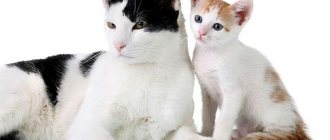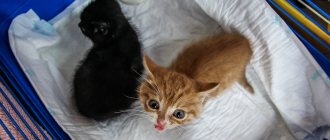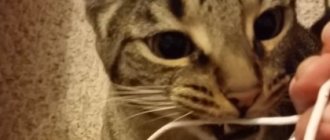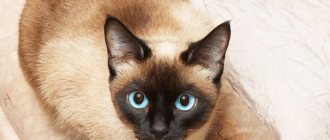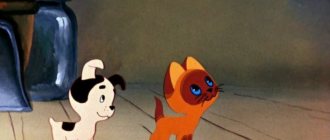- External structure of a cat Cat's head Eyes
- Ears
- Language
- Jaws and teeth
- Paws and claws
- Skeleton
- Reproductive system
Representatives of the cat family are the most graceful animals in the world.
High jumps, amazing balance, lightning-fast movements, silent movements - this is not a complete list of the capabilities that cats have. This is primarily due to the peculiarities of the cat’s structure. The internal organs in their location and functions are similar to the structure of other mammals, however, they have a number of special differences. The cat's body has more than 500 muscles of varying sizes, which allows it to perform all these different physical activities that sometimes amaze spectators. The cat’s brain is also very developed, it reacts quickly, coordinates the actions of the animal, using the structure of the body along with all its advantages. It is precisely because of the speed of reaction that they probably say that “a cat has 9 lives,” because it can group itself in an instant and thereby save its life.
External structure of a cat
The anatomical structure of a cat is incredibly organic and cannot but please the eye. Small size, cute face, soft paws, long flexible tail, fluffy fur - all this distinguishes cats from other animals. All parts of the body of these animals have their own charm and practical purpose, but at the same time they can hide certain secrets. For example, paws at first glance are completely harmless, but they hide the main weapon - the ability to release claws. Just like the cat itself, a seemingly affectionate pet, but at the same time a real predator.
Cat head
Eyes
The structure of a cat’s eye differs little from that of a human and a cat sees according to the same principle as we do – it reacts to light. The pupil tends to increase or decrease with the help of a special muscle, and its size depends on the amount of light. In the dark, a cat sees with the help of a special layer of the choroid - tapetum. It serves as a mirror that reflects the light received by the eyes, and due to this, vision is sharpened. The tapetum is also the reason why a cat's eyes glow in the dark.
Ears
The structure of a cat's ear allows it to detect more than 100 sounds, including ultrasonic sounds, with the help of which cats communicate with kittens. The auditory canals also contain an incredible number of nerve endings and more than 10 muscles. This is why cats can change the position of their ears on their heads - press them down, bend them, turn them towards the sound, etc.
Language
The structure of a cat's tongue is of some interest, primarily due to the fact that the animal manages to drink only with its help. The tongue is long, very flexible and, unlike, for example, a dog’s, very rough. The “sandpaper” effect occurs due to the keratinized papillae, which help retain food and also act as a kind of brush for cleaning the fur. In addition, the tongue performs a function that is familiar to us - recognizing the tastes of food. A cat can taste salty, bitter, sweet and sour.
Jaws and teeth
The structure of teeth in cats is of great importance, since teeth are one of the most important tools for hunting or, conversely, protection. An adult cat has 30 teeth, which are symmetrically located on the upper and lower jaw. The main tool for catching prey is 4 canines - these are the longest and sharpest teeth of a cat, 2 on each jaw on the sides of the incisors. With the help of incisors, cats tear off pieces of food, but cats' jaws are not adapted for chewing, so food begins to break down already in the oral cavity under the influence of saliva.
cat body
According to their build, cats are divided into three types: heavy, light and medium. The severe type is characterized by the presence of a large cat head on a short neck, a wide chest and rather short legs and tail. Lightweight - with a slender body, a long neck and a narrow head, as well as a long tail and paws. The medium type is somewhere between heavy and light, and most cats, especially non-pedigree cats, are of the medium type. But the appearance, weight and size of a cat does not depend on its build; there are both representatives of the heavy type, but small in size, and large slender cats.
Paws and claws
The structure of a cat's paw is especially curious because the claws can extend or retract. Cats have 5 toes on their front paws, but one is shortened and does not reach the ground. There are only 4 toes on the hind legs, the big one is missing. It is also noteworthy that the cat walks only on its toes, which, of course, contributes to noiseless movement. A cat's paws concentrate all the sweat glands and many nerve endings, so the cat can also receive information by touching an object with its paw.
The structure of the claw is unique; most breeds have crescent-shaped claws, with the exception of Persian cats with claws that are more reminiscent of hooks, which pose a particular danger when scratching, as they get under the skin.
Tail
The structure of a cat's tail is usually divided into 3 parts: the root, the stem (actually, the tail itself) and the tip. The root consists of 4-6 short and wide vertebrae, the stem of 10-15, which are cylindrical in shape, and at the tip there are 5-7 of the thinnest and smallest vertebrae, the very last of which may be undeveloped, often sharp. Between the vertebrae there are cartilages and joints, they provide the tail with flexibility and mobility. The tail can help a cat maintain balance, but its significance is more visual, and it is also one of the tools of the cat's language.
Story
There are two versions of the origin of the breed. According to the first legend, Maine Coons originated from crossing a cat with a female raccoon. The only evidence here is the similarity of color. But, given the fact that we are talking about representatives of two different suborders of the order of predatory mammals - canines (which includes the raccoon family) and felines, this legend is far from reality.
The second, more plausible legend is the crossing of a cat and a lynx. This is supported by the similarity in color, size, and shape of the Maine Coon’s ears. But this version is not supported by serious researchers; most likely this amazing breed is the result of evolution without exotic crosses.
The breed got its name from the American state of Maine, and its first representative to gain worldwide fame was the cat Captain Jenks, shown in Boston in 1861. At one time, interest in this breed faded; representatives of the Persian breed were more popular in the late 19th and early 20th centuries. But it was preserved thanks to the interest of American farmers who liked the size and hunting qualities of Maine Coon cats. Today this breed is popular in many countries around the world and is a constant participant in various shows and competitions.
Internal structure of a cat
The organs of a cat are basically the same in location and function as the organs of other mammals. A cat has skin, skeleton, heart, respiratory, circulatory, digestive and reproductive systems. A cat's skin is very elastic and mobile, it has many muscles and blood vessels, as well as sebaceous glands that secrete fluid, which the cat distributes throughout the coat when licking, providing it with smoothness. The structure of internal organs is largely determined by the evolution and characteristics of the species.
Skeleton
There are more than 240 different bones in the skeleton of a cat, and, as you can see in the photo of the cat’s skeleton: at one end of the spine there is a head, at the other there is a tail, like all vertebrates. A cat's bones have many functions: they form the basis of its body and also protect its internal organs from damage. For example, the structure of the skull is such that its bones protect the brain and organs of vision, and the ribs protect the heart and lungs. The bones of the cat's inner ear perform the function of transmitting sound, due to which the cat has hearing. Kittens are born with all bones, and by the end of the first year of life they usually reach their maximum size.
Internal organs
The structure of the organs of cats is basically the same as that of all mammals. The main organ is the heart, located inside the chest, behind the ribs and consists of 2 atria and 2 ventricles. The weight of the heart is usually approximately 0.6% of body weight. A cat's respiratory system is designed to function in a wide variety of environmental conditions. The photo of the structure of the organs perfectly reflects the digestive system of a cat, which has several features: saliva begins to break down food in the oral cavity, and this process continues in the stomach, and then in the small intestine (its length is 4 times the length of the cat). A cat's kidneys are located in the abdominal area and perform the functions of removing toxins and maintaining water balance.
Maintenance and care
Caring for Maine Coon cats means, first of all, taking care of his health, timely visits to the veterinarian and having all the necessary vaccinations. It is recommended to vaccinate against ticks, regularly take prophylactic antiparasitic drugs, and take essential vitamins. Like any cat with thick hair, it is necessary to use a special paste to empty the stomach of hairballs, and it is also useful to grow grass that helps in cleansing the digestive organs. It is advisable to comb the coat at least 1-2 times a week.
For nutrition, you can use special food designed for large cats or natural products. With any choice, you need to keep quality and variety in mind. You can feed him lean meat (beef, rabbit, chicken) or boiled lean fish without small bones. It is advisable to supplement the diet with vitamin and mineral complexes, vegetables mixed with meat, kefir, low-fat cream and cheese.
Differences in the structure of cats
The internal structure of a cat differs from the structure of a cat in its reproductive system. Outwardly, this manifests itself in the fact that in cats, the scrotum is located just below the anus, while in cats, in this place there is a slit-like vagina (vulva), which can be seen in the photo.
Reproductive system
The cat's genital organs are the gonads, the testes in the scrotum, the penis and the spermatic cords, which connect to the urethra. The components of a cat's reproductive organs are the vulva, vagina, uterus and uterine tubes. Cats reach puberty at the age of 6-8 months, but this does not mean that by this moment they stop growing, just that the genitals have already formed and can be used to reproduce offspring. The endocrine glands also play an important role: the adrenal glands, the thyroid gland and the hypothalamus; they regulate many processes in the cat’s body and protect against many diseases.
Relationships with children and pets
Maine Coons get along well with children; they are one of the calmest and most forgiving breeds that love active games. Of course, you should not play with the animal for too long and provoke it into active actions. After games you need rest.
Another pleasant characteristic of cats of this breed is their normal relationships with other animals. He will get along well with another cat or dog; their large dimensions and weight allow them not to be afraid of many domestic dog breeds. As for small birds, hamsters, rats and other rodents, such coexistence is undesirable and requires special precautions. Still, the hunting instincts of cats can play an evil role here.


